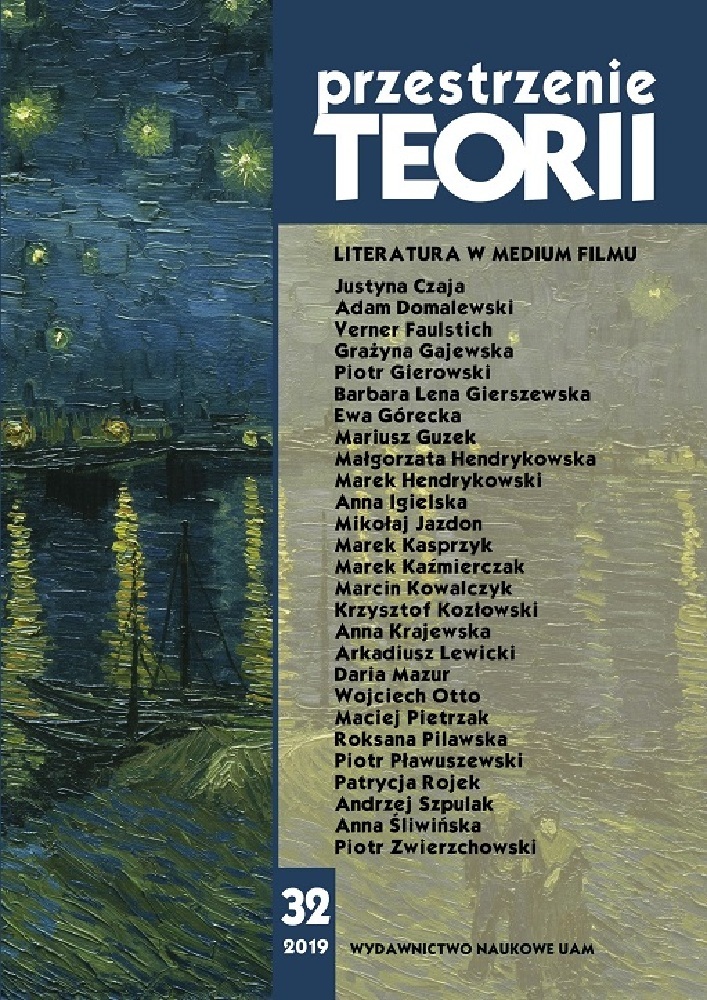Abstrakt
Lewicki Arkadiusz, Prosta droga do melancholii. O antyutopii 451 stopni Fahrenheita Raya Bradbury’ego i jej filmowych adaptacjach [The Easy Route to Melancholy. 451 degrees Fahrenheit by Ray Bradbury and its Film Adaptations]. „Przestrzenie Teorii” 32. Poznań 2019, Adam Mickiewicz University Press, pp. 257–272. ISSN 1644-6763. DOI 10.14746/pt.2019.32.13.
The article is an attempt to interpret Ray Bradbury’s anti-utopian novel 451 degrees Fahrenheit, published in 1953, and two film adaptations of this book: the film directed in 1966 by François Truffaut and Ramin Bahran television adaptation from 2018. All versions have a similar story structure and tell about the near future, in which the main task of the fire department is burning books. The differences consist in shifts of emphasis within the world presented. The author proves that the 1966
version shows a possible world, which is “an audio world”, while in Ramin Bahrani’s work we are dealing with the “pictorial world”; in the 1966 film the written word is replaced by sounds and the spoken word, and in the version from 2018 by paintings. These differences indicate not only different possibilities for interpreting Ray Bradbury’s novel, but also transformations that took place at different levels of the reality surrounding us.
Bibliografia
Antonik D., Audiobook. Od brzmienia słów do głosu aktora, „Teksty Drugie” 2015, nr 5, s. 126–147.
Barthes R., Krytyka i prawda, przeł. W. Błoński, [w:] Współczesna teoria badań literackich za granicą, t. 2, oprac. H. Markiewicz, Kraków 1976, s. 125–163.
Bradbury R., 451 stopni Fahrenheita, przeł. W. Szypuła, Warszawa 2018.
Corbain A., Kulisy, przeł. W. Gilewski, [w:] Historia życia prywatnego, t. 4. Od rewolucji francuskiej do I wojny światowej, red. M. Perrot, Wrocław 1998, s. 431–627.
Eco U., Nauka i fantastyka, przeł. R. Kłos, [w:] Spór o SF. Antologia szkiców i esejów o science fiction, teksty wybrali: R. Handke, J. Jęczmyk, B. Okólska, Poznań 1989, s. 170–178.
Kaneda T., How Many People Have Ever Lived on Earth?, <https://www.prb.org/howmanypeoplehaveeverlivedonearth/> [dostęp: 4.09.2019].
Lem S., Fantastyka i futurologia, t. 2, Kraków 1989.
Markiewicz H., Wymiary dzieła literackiego, Kraków 1984.
Markowski M.P., Ciało, które czyta, ciało, które pisze, [w:] R. Bathes, S/Z, przeł. M.P. Markowski, M. Gołębiewska, Warszawa 1999, s. 5–34.
Number of TV Households in America, <http://www.tvhistory.tv/facts-stats.htm> [dostęp: 27.08.2019].
Ośrodek Badania Opinii Publicznej i Studiów Programowych, Komunikat z badań nr 31, maj 1974. Zajęcia kulturalne, <http://www.tnsglobal.pl/archiwumraportow/1974/04/02/zajecia-kulturalne/#more-3593> [dostęp: 3.09.2019].
Postman N., Zabawić się na śmierć, przeł. L. Niedzielski, Warszawa 2002.
Włodek P., Kres niewinności. Obraz i upamiętnienie ery Eisenhowera w amerykańskich filmach i serialach – pomiędzy reprezentacją, nostalgią a krytycznym retro, Kraków 2018.
Wojtczak D., Siódmy krąg piekła. Antyutopia w literaturze i filmie, Poznań 1994.
Licencja
Autorzy
Autorzy tekstów przyjętych do publikacji w czasopiśmie „Przestrzeniach Teorii” są zobowiązani do wypełnienia, podpisania i odesłania na adres redakcji umowy o udzielenie nieodpłatnej licencji do utworów, z zobowiązaniem do udzielania sublicencji CC.
Zgodnie z umową, autorzy tekstów opublikowanych w czasopiśmie „Przestrzeniach Teorii” udzielają Uniwersytetowi im. Adama Mickiewicza w Poznaniu niewyłącznej i nieodpłatnej licencji oraz zezwalą na użycie sublicencji Creative Commons Attribution-NonCommercial-NoDerivatives 4.0 International (CC BY-NC-ND 4.0).
Autorzy zachowują prawa do dalszego, swobodnego rozporządzania utworem.
Autorzy, którzy wykorzystują w swoim tekście cudze utwory (np. ilustracje, fotografie) proszeni są o dostarczenie do redakcji czasopisma zgodę na publikację od uprawnionych podmiotów.
Użytkownicy
Zainteresowani użytkownicy internetu uprawnieni są do korzystania z utworów opublikowanych po 2015 roku „Przestrzeniach Teorii” tylko w calach niekomercyjnych, pod następującymi warunkami:
- uznanie autorstwa - obowiązek podania wraz z rozpowszechnionym utworem, informacji, o autorstwie, tytule, źródle (odnośniki do oryginalnego utworu, DOI) oraz samej licencji;
- bez tworzenia utworów zależnych - utwór musi być zachowany w oryginalnej postaci, nie można bez zgody twórcy rozpowszechniać np. tłumaczeń, opracowań.
Do wszystkich tekstów opublikowanych przed 2015 r. prawa autorskie są zastrzeżone.
Inne
Uniwersytet im. Adama Mickiewicza w Poznaniu zachowuje prawo do czasopisma jako całości (układ, forma graficzna, tytuł, projekt okładki, logo itp.).
